INTERAKTIONS-THEORIE
no. 2
dresses
(in emergencies)
Johannes
Birringer
The laboratory starts and the participants gather. We get to know
each other as we set up the studio spaces, share the lab tools, the work time,
the meals, the guest house where we sleep, the performance space where we warm
up in the morning, the "augmented reality" architecture built for
Suna no Onna.
There are two projects which have been initiated. The beginning
is slow. All beginnings (when the group process and the dynamics establish themselves)
have such an overture. The early dress rehearsal of the production-organization,
conjoining teams, units, members of teams into a coherent workforce. We try
to talk (in language) about the Suna no Onna and the Daedalus_exMachina
projects, the precise explications fail but we are drawn to the images, objects,
and the excerpts (projected digital images, website archives, documentations)
from elements of previous work by the artists and programmers leading up to
the new explorations. Ideas float in the space.
Nancy Mauro-Flude demonstrates her "paraphernalia",
a refreshingly bizarre concoction of an interface-joystick-remodified-voodoo-doll.
She speaks about performing vaudeville, a kind of digital cabaret (greetings
from Valeska Gert), and doing it live yet within/inside the virtual world of
a mod-game landscape (created by Walter Langelaar, with navigation sound by
Scot Cotterel). Her starting point is a theatrical model of performance, but
here infused with the knowledge of coding, software, and new media tools, game
engines, webstreaming performance techniques. In one of her documentations of
a previous performance with her paraphernalia, she is seen wearing a long extravagant
yellow gown, and her magic wand is a long rod with which she tele-transports
her audience.
Wearing the interface (in the era of the digital virtual deluding
the analog).
this is one of the challenges of Suna no Onna, a project
that also was conceptually presented at the first lab workshop. The work is
"in progress" as a research investigation and a "stage"
production" (SensorDress prototyping of garments with built in sensors,
Screen Dress prototyping using special reflective chromatte material, and CaptureDress
prototyping - a design-in-motion concept using captured data from the performer
wearing the dress). What kind of production it is was debated, and in the following,
I will write a continuing textstream, to be slightly expanded and contracted
each day of the lab, which interrogates the story of emerging dress or dressing
for emergence. My notes are - unlike F.Scott Taylor's philosophical reflections
- mostly focused on performance methodology.
Emergence is wearing.
Before I attempt to elaborate on the notion of the emergent
dress, which Michèle Danjoux and myself have formulated after a series
of testings in the DAP-Lab over the last two years, exhibited and reformulated,
formulated again and
re-exhibited, I want
to admit that the "narrative" core of the new work, which is conceived
as (1) a stage performance and (2) an interactive installation and (3) a film
/ and / interactive DVD, is slightly complicated, and perhaps contradictory.
I will tell a brief version of "Suna no Onna" (Woman in the Dunes),
in a moment, but before telling stories, here's a dialogue that evolved about
where one can install new work in this day and age, and what choices some artists
make. Since our group is undecided about the nature of the venue Suna no Onna
requires, I want address the question of physical site and virtual spaces (projected
spaces).
Sent: Tue 7/17/2007 5:50 PM
To: PIRATE@ Performative Interdisciplinary Research in Art and Technology
Subject: The SYLGRUT Centre in Second Life
Dear pirate list members,
I have recently been developing The SYLGRUT Centre for contemporary
media art and critical theory in Second Life, please make a search
for the "SYLGRUT Centre" or "media art" if you already
have or when
you do have an avatar/user name in Second Life, hopefully you can
find it and teleport yourself there. I have already installed some of
my own experiments in order to establish a presence in the space. But
the essential purpose of The SYLGRUT Centre Galleries, SkyLab and
Residency Studio is to host, support and present artists work in
Second Life.
And so it occurred to me today that this represents the possibility
of hosting the first PIRATE group show at the centre. Perhaps there
are some list members who would be interested in participating or
have already started to make some experiments of their own.
There is a lot more information at the SYLGRUT Centre, this email is
just intended to announce the centre.
Best, Paul Sermon
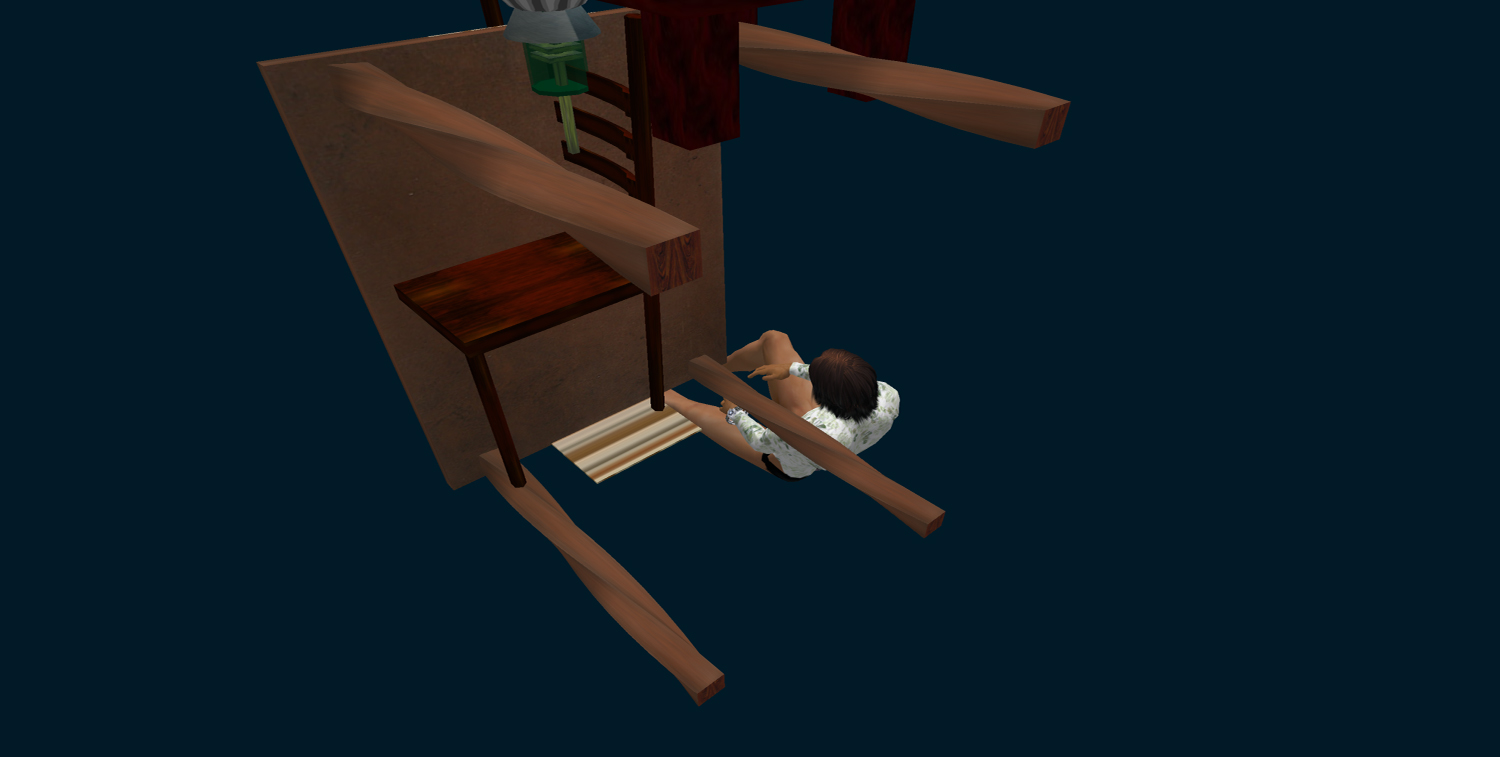 Paul Sermon screenshot in SL
Paul Sermon screenshot in SL
Second Life redux. We pondered it last year at the Interaktionslabor
2006, and drew on the "game engine" idea to think about creating a
live computer theatre performance, enacted by live avatars/performers. The protagonist
performer-avatar wore sensors to control the rmovement inside the virtual (projected)
world. Two other avatars were live-linked via webcam to the geographies of the
game world.
What is a projected space? can one wear it and "control"
an environment? How does the environment respond to the interactive presence,
and what is an interactive (avatar) presence. The discussion in our lab, and
in the context of Interaktionslabor's mission to further the exploration of
new interactive performance/communications, is of course about the various types
of interactive enactment, embodiment, and control, the various types of presences
of performers and avatars, the embodiments and the role and experience of interfaces.
And therefore such discussion also concerns the placement of "interactive
art" for the audience, for active audience participation. There are two
levels at which our discussion during the first week of the lab involved interactivity:
the level of the work's honesty (what is newly developed and crafted by technological
art, programming, and interactive environment composition?) and, then, the level
of the work's reception by an audience which needs to be aware that it is watching
a particular, unique, emergent, unpredictable, interactional presence. The perceptional
truth of an audience watching an "interactive" performance can be
said to reside in the "believability" of the technological interface
controlled or manipulated in real time by a performer who has an impact on her
or his environment. The matter of such a truth is not negligible, since audiences
are sophisticated in observing the behavior of performers and systems, and know
that reactive/responsive behaviors (in the media) can be "faked" by
using prerecorded data and precise cueing.
Something in the myth of interactivity, and the stories it has
told us, is therefore wearing down of course, and the glamour of the first generation
mapping of interactive interfaces (action-reaction/stimulus-response model)
has long worn off. The second generation of indirect interfaces involving motion
sensiing systems promises more; it address real-time movement or gestural inter-action
with intelligent systems (AI) and a more rigorously theorized self-organizing
environment, or a system that envelopes or generates autopoietic dimensions,
and participatory interaction between user and environment, between user and
"art object."
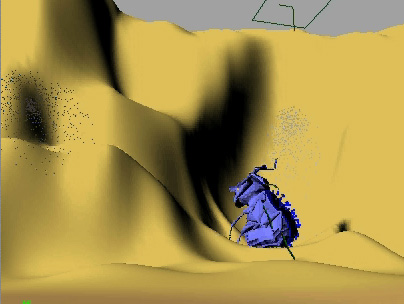
animated beetle in sand landscape, to be played
by dancer
Naturally, there is no more art object in the so-called virtualism
of interactive, immersive or distributed art. Naturally, if you wear a specially
designed fashion dress, a garment that includes sensitive electronic accoutrements
or built-in (bespoke) intelligences, then there is an object after all. The
interface garment is an object and it is an instrument. Some practitioners are
refering to the interface itself as the "object" (instrument), comparing
it in analogy with a musical instrument that needs to be played. As Paul Verity
Smith noted, the trumpet builder did not just design an instrument to be played
with, but one that generates a very particular sound and has to be played in
a particular manner with the lips, breath, tongue, fingers, etc. It requires
a precise and subtle techniques and knowledge of the capacities and particular
responses of the sound instrument. If one looks at the range of sensors and
motions sensing/capturing systems, it is much the same. The interface design
would seem to require not a naive unprepared user but someone who has mastered
a technique. There are differerent sensors in the family, and some could be
used as basic interface instruments (on/off switches, photocell, proximity sensors),
whereas the more complex measurements of 2D G-force or 3D G-Force accelerometers,
bend sensors, orient sensors, etc., require a more intimate awareness of what
the sensor measures of a gesture or movement, and what data it sends to the
computer program. Furthermore, there has to be a clear decision process as to
what kind of media output the measuring data will impact or controll (sound,
stills, motion graphics, digital video/movement images), and how they will impact
the sound or images or lights within a particular compositional environment
for performance.
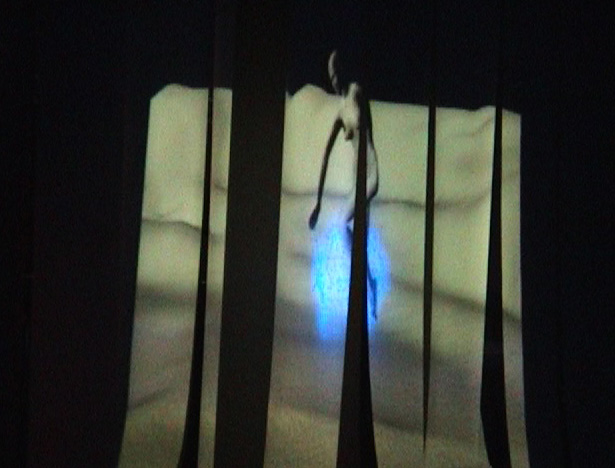 .
.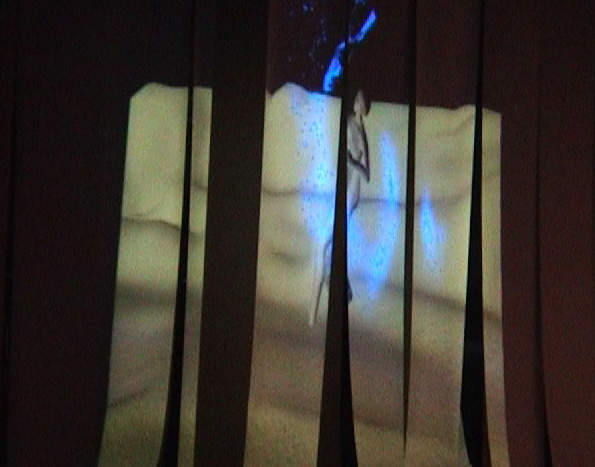
"Sandwoman" sequence, digital figure
dancing with Helenna Ren and being danced by her (sensor-interface)
On the other hand, the Suna no Onna project is a performance
work which is created to project a specific content, based on a narrative about
the existence of a woman who lives in a particular, difficult habitat-environment
(sand dunes). As an existential allegory, the work approaches questions of behavior
under conditions which (for the woman and for her guest, the tourist-scientist
from Tokyo who is looking for insects and stumbles across the sandy habitat
only to become her captive) require adaptation.
There is also the spirit of the village, who appears and disappears,
unsettling the scientist who has been 'delivered' by the village community to
the lonesome woman's habitat.
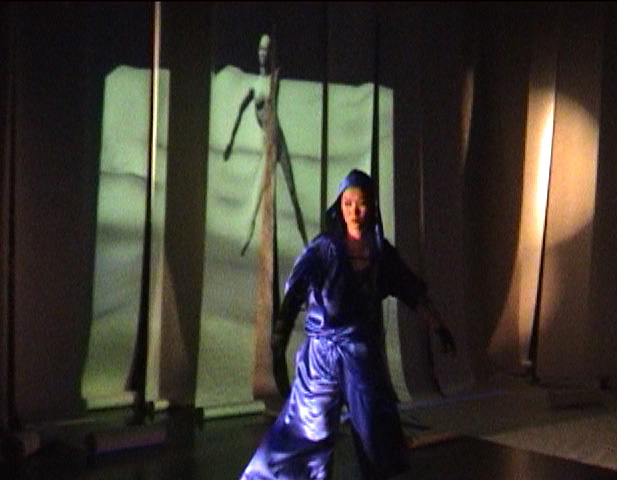
Helenna Ren as spirit
One question that came up in our group discussions concerned the
relationship of (conventional) linear narrative to (equally conventional) nonlinear
narrative fragmentation or abstract distribution. The narrative, in this case,
is not coincidental, but drives the image movement and the physical movement.
It therefore also has a distinct relationship to the embedded interactional
technologies or instruments. The configuration of the work is not completely
interactive, in the sense of a computer-programmed or programmable environment,
but uses the "controller" functions and mappings subtly, without pretense.
Suna no Onna is not interactive art, properly speaking, as it does not (yet)
include the audience as active participant. The performers train with the environment,
and the environment becomes embedded in an interactional and digital performance
system. The system, at the same time, is meant to be embodied by the performers,
it is the group's collective intelligence which explores the real-time potentials
of the narrative, visual, tactile and sonic (as a system for/of behaviors).
This is a primary level of describing the Versuchsanordnung (experimental arrangement).
A set of conceptual questions arises from this.
21/22 July, 2007.
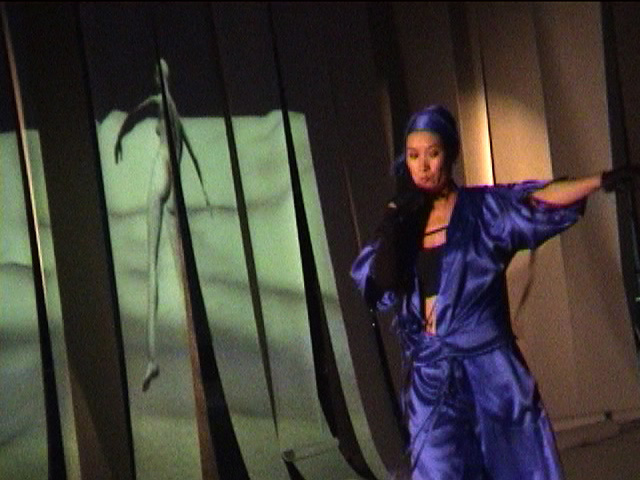
Interactivity is wearing
In the following, some reflections on "interaction "
following a meeting with the director of the Industrial Culture Commission,
the agency which has enabled our lab to set up operations in the Coal Mine.
An edgy conversation took then place on the third night of the lab, when the
lab participants met the civil engineer who works for the Mine infrastructure
change. He asked about where we want to go, why we examine "interactivity,"
what outcomes we imagine, what new technological applications we build or what
kind of art are we professing to make (with "new technologies" which
are not quite new). For example, he questioned why the lab is still worried
about sensors and interactive art works, and if so, what do we claim to have
proposed that is not just technical play or gimmick (playing to see what is
possible, trying out in lab tests), have we furthered artistic concepts or created
a new art form.
The discussion lasted several hours, there were few answers. But we came to
the conclusion that it might be a good moment for our lab (after 5 years of
annual laboratories, and after the 2006 Walhalla production) to step forward
and release a manifesto, or a proclamation in which we address what it is we
make. We don't write new software, although we write code and we modify existing
software. We do not build our own sensors, nor have we delivered a useful product
to rehabilitation, medical or sports sectors. None of our intelligent dresses
are very intelligent, although they are beautiful and could be shown to the
fashion market. We have not supplied any markets yet, and the research on sensors
is progressing very slowly. It appears that each year (with different artists
joining the lab), we start again, to perform with one sensor, with another accelerometer,
with a handful, and then with two handfuls of sensors. This year, Suna on Onna
also uses a complicated array of visual "objects" to control (motion
capture derived data for digital 3D animation, special camera generated motion
graphics for chromatte material, digital video, still photography, sonic materials).
The interface rehearsals are slow, as we are developing all materials at the
same time (parallel). The PD programming of the interactive patches is going
slowly. Paul told us that some sensor data do njot transmit due to thick/heavy
cloth. as
It therefore is not entirely accurate to say we operate as a science
lab, building/engineering new data or software or hardware, or generating new
performance behavior under controlled conditions of observation. We onserve
our rehearsals and the performances,of course, but initally we still do basic
testing, and if one wanted to test the accelerometer, one needs a laptop and
an accelerometer, and then move the sensor and observe how it sends data, and
how the controller function can affect images, image movement, image quality,
sound movement, sound behavior.
If the lab is dedicated to advanced art making, then the outcome
of such "technological" art needs to be scrutinized as well.
If we come up with a proposition for an interactive design-movement installation,
which can have an impact or affect on audiences (and alters or expands the notion
of the work of art or the art discipline our audiences are accustomed to receive
and to react to) or on us, on the specific techniques of the presenting artists/designers,
then we can formulate this.
The prototype development requires foregrounding design, but also
biological and cybernetic concepts for the real time interaction environment
(complexity, emergence, unpredictability, simultaneity). The performer is not
choreographed, the "script" is not fixed. The creativity of the emergent-design
performer is specifically a complex-enaction of real time probabilities; the
performance is unique each time, it is individual, specific, and can only be
experienced in the ephemeral time of the design enactment. As a game, however,
the game cannot be played by the audience. In the arrangement for Suna no Onna,
the audience is not "wired into" the scenario. How can they become
more affectively, emotionally and cognitively involved, how do they partake,
and what do we want them to experience? Do we need our audiences to experience
the direct mapping (of gesture to data output) and the -- virtuosic -- technique
of the performer using the instrument?
Interactivity's assumption is a form of reciprocation: the "user"
or experiencer, the immersant or interactor is necessary, in the particular
contingent situation of a "game" or an interactional art work, to
complete the action or act. If there is no actor, there is no "work,"
common wisdom in the interactive art design claims. This is similar to the fundamental
principle of gaming as action. Without the gamer playing the action and engaging
the levels of the game, the game does not exist.
Yet this is not quite accurate, since the builder of the installation
or performance or game scenario will have programmed the path and the probalities
of use, and as in games there tends to be a suspension mode for the action of
the interactor, and an auto-play mode (diegetic and non-diegetic sequences).
The self-organizing system of a real-time biocybernetic installation
(using motion sensing, infrared or other AI technologies to generate/regenerate
behaviors and phase states) of course ought to be able to learn from interactive
actions in the environment, and if there are none, that non-activity will be
learnt as well.
In the case of Suna no Onna, the arrangement is not
a game, but a narrative is composited by/for three performers and an environment.
In this habitat, the performers' movement and the digital choreographies (acted
on by the sensorial interfaces worn by the performers) conjoin. It is this conjoining
which we refer to as "wearing the digital."
What do we want our performers to challenge with?
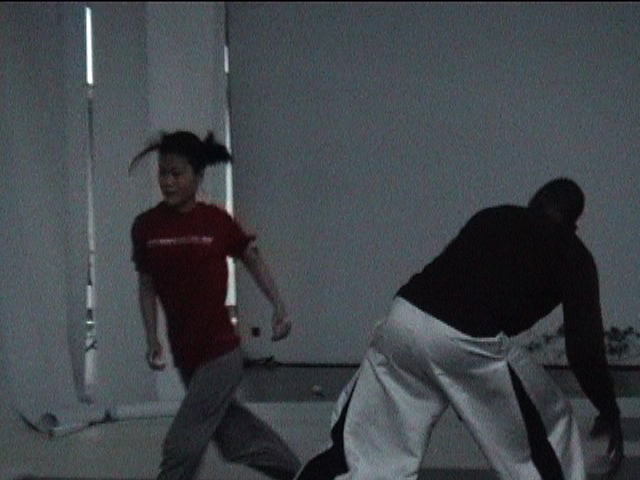 .
.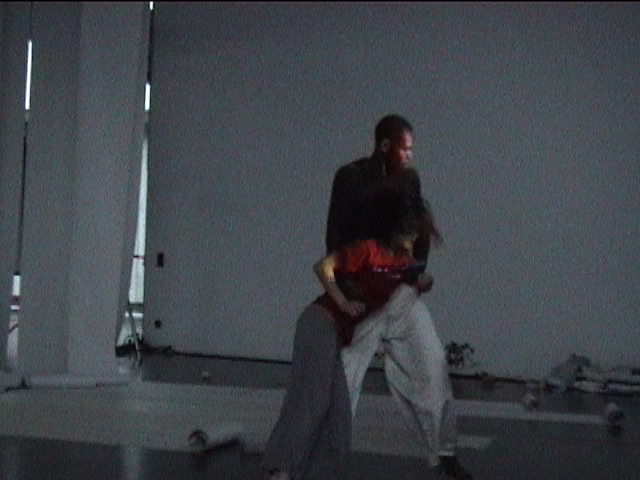
23/7/2007
Emergencies
The sensors measure certain activities (movements), angles, speed,
distance (proximity), heat, pressure, velocit, force. This last term already
is diffuse, and when you look carefully at sensor interfaces, many interesting
contradictions arise. In artistic research - for example - working in a dance
performance in which sensor interfaces are used to "control" sonic
or visual/projected media output, often there is not enough deep research into
understanding the various functions (and restraints) or sensors worn on the
body or built into the body garments.
The 2GForce Sensor is a tilt sensor (measures angle) and accelerometer
(measures velocity) in one.
The iCube sensor production company (Infusion Systems) says this:
GForce2D-2 v1.1
Two sensors for the price of one. Senses dynamic acceleration (or deceleration)
and inclination (tilt, ie. static acceleration) in two dimensions simultaneously.
Detects upto ±2 G acceleration and a full 360° in two tilt axes.
It's a visually exciting sensor ! Can be held in the palm of your hand. See
this videoclip for a demo of its acceleration sensing capabilities and this
videoclip for a demo of its tilt sensing capabilities.
In our rehearsals with the emergent dresses today we shall start
with a scientific approach into the mesaurements and the actual mathematics
of the sensors. We shall go back to degree zero, and then ask the performers
to wear the sensors to disover what the "patch design" does to determine
what effect the controller functions have for the digital projection objects
and the sound, and thus the synaesthetic experience of the scenes as a while
(from the reception point of view).
25/7/2007
Control and dialog
Performing with the sensor behaviors involves an analog process
of perceptional and motivational intercourse with the "virtual" (the
projected landscape and digital projection objects). Although often refered
to as a "controller," the interface in our performance is more accurately
defined by the dramaturgy of the narrative (Suna no Onna) and the performer's
interpretation of her or his role. In this sense, the performance more closely
resembles a dialog with the digital objects and animations. In Suna no Onna
we use five different intelligent garments, designed by Michèle Danjoux,
and each garment or garment part will be equipped with its own "transmitter"
system wired up with a specific sensor.
Sensor garment collection:
Helenna Ren: sensor glove with 2Gforce, Wi-microSystem, and
battery (blue Sandspirit dress)
Helenna Ren: sensor glove with 2Gforce, Wi-microSystem, and
battery (blue Beetle dress)
Katsura Isobe: Mercury sensor array with Wi-microSystem, and
battery (Outer Sand Coat)
Katsura Isobe: 2Gforce, Wi-microSystem, and battery (work glove,
leather manchette)
Katsura Isobe: photocell sensor with Wi-microSystem, and battery
(fishskin garment)
(Olu Taiwo: photocell sensor or orient / bend sensors with old
Wi-microSystem, and battery (white gown))
The performance of Suna of Onna has, in many scenes,
three performers in action, which challenges us to program the transmission/reception
of sensor data coming into the PD patch from the entire sensor garment collection
(above) worn by the dancers. Each sensorial garment is active throughout the
duration of the performance. The software receiving the sensor data (via bluetooth)
is running underneath the PD patch which controls the digital scenography and
media outputs on the triptych screen environment. Sound is generated in real
time on a separate system (Oded Ben-Tal) running on a PD patch inside a PC.
The Scenography PD patch is running on an Apple G5 (MacPro) desktop computer
which has a TripleToGo output VGA hardware component which sends the video signals
simultaneously to three LCD projectors. The projection output, in the Suna no
Onna landscape environment, has the following look (rehearsal photo):
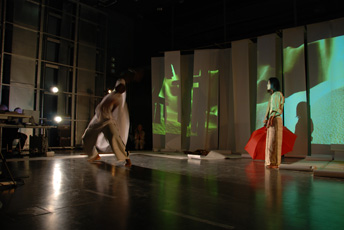 .
.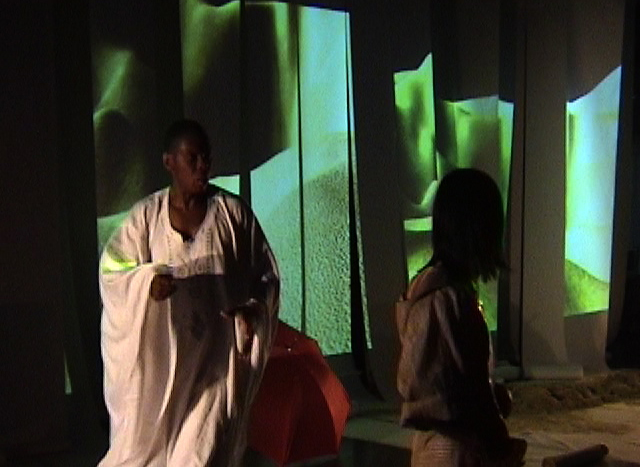
Olu Taiwo and Katsura Isobe, Scene 4, Life in
the Sands
Dialog is a intersubjective enactment which we understand as a
form of incorporation, the digital or the extra-sensorial is "socialized"
in the theatrical embodiment of a narrative which is, explicitly, allegorical
in so far as it involves an existential setting in a virtual environment, created
not with backdrops or built environment but entirely through modeling and digital
means (animation, motion capture, motion graphics, digital video). Our film
narrative is from the 60s; the pervasive computing environment is the contemporary
& future ecology which suggests that the human (social animal) learns to
exist within the globalized spectrum of augmented and nertworked/distributed
environments, a physio-psychological challenge which F. Scott Taylor, in these
theory pages, will address from his own critical perspective on abnormal
mediational and dissociative processes. There is also a political and social
dimension, which Taylor has also addressed in his reflections on intersubjectivity
in the era of electrocracy.
The liveliness of the environment, or its self-governing aspects,
is evoked through the programming of ennvironmental "digital characters"
(Marc Downie and Paul Kaiser, when they speak of "thinking
images" and agent-based artifical intelligence-generated art in dialog
with stage performance, use the term "creatures" for the aninated
shapes and figurations they created for behavior in response to the action on
stage) which appear and are conversing with the stage characters.
27/7/07
Emergency
Last year, Interaktionslabor housed the "Walhalla" project
and the development of a live computer game, and in the research for the composition
of the game, the members of last year's group met for a sequence of dramaturgical
workshops. As we discussed games and game engines, as well as the psychogeography
of the city and the behavior of obsessive-compulsive game players, Sher Doruff
(a team member from the Amsterdam partners of the project and an alumna of Interaktionslabor)
gave me an essay she had written some time ago, in response to the live media
practices of artists using real-time, multi-player platforms to create networked
performances. I noted that Doruff was punning on the biological concepts of
emergence and also theorizing the real time dimension of unpredictable
(chance) operations in the distributed composition of content or media-experience.
I quote from her crtitical reflections on her workshops, since they are fundamentally
pertinent to our explorations.
Collaborative Culture and EmergentC’s
A remarkable, if contentious, trend of the past few decades, has been the
transdisciplinary current of complex system theory running through and between
all fields of research practice, from physics, biology, neurology, the social,
computer, political and cognitive sciences, to philosophy and art. Though
interpretations and assessments vary, there is an appetite for models and
methodologies that reveal elements and conditions of non-linear dynamic
interaction in systems; in cells, in brains, in social networks and human/computer
convergence. It is a study of the interaction and organization between things
in their environment and the processes that emerge from these conditions.
The dynamics, the enigmatic inter-ness – flow, dynamic, movement,
process, synapse, circuit, stigma, information – ‘between’
organisms, nodes, individuals and societies is the stuff of life. Complexity
provides a provocative contextual topology from which to approach a discussion
of collaborative practice in new media and live arts. The focus here is
on practice that extends well beyond the conventions of working relationships
in interdisciplinary arts projects and moves towards a synergy that marginalizes
individual contribution over the relational dynamics and emergent possibilities
of the collective. That same collective that can only flourish from diversity
and difference among its group; that looks towards the inter-authorship
process as viable artistic expression; that builds and uses media technologies
that both reflect upon and engender new types of social interaction and
critical discourse.
The implications of emergent social behaviors, communication
skills and aesthetics arising from collaborative interplay and its dynamic
properties is potentially far-reaching given the cross-cultural breadth
of informatics. Much of this discussion in theoretical practice is old news,
worn thin from cybernetics to rhizomatics. The vivid plausibility of empowered,
emergent networks sits uncomfortably on the utopian/dystopian dialectical
fence. Global political trends as a case in point, contribute to the dualism
between neo-nineteenth century hierarchical colonialism and the bottom-up
revisioning of twentieth century social democracies.
Distributed real-time interaction strategies and negotiations for data sharing
and processing are examples of dynamic systems with a high degree of complexity,
just as culture itself can be viewed as a highly complex system. I will
point to contingencies that appear relevant with respect to issues and phenomena
that address emergent behavior and distributed cognition within collectives
that are connected and facilitated by malleable media. The unpredictable,
elastic modification of this media by multiple users is essential to this
discussion. As the term “Collaborative Culture” suggests, this
essay and the masterclass at DEAF03 in March, are an attempt to provoke
both critical and playful investigation into tools and techniques that incorporate
social networks, live mediation, synchronous co-creation, real-time access
to and transformation of databases and living archives. The technology enabling
the practical interplay for the class was KeyWorx (Waag Society), the theoretical
topology was complexity.
[Doruff, Sher, "Collaborative Culture,"
in Brouwer, J., Mulder, A. , Charlton, S., eds. (2003) Making Art of
Databases. Rotterdam: V2_ Publishing/NAI Publishers, pp. 70-99]
In the following, Doruff then proceeds to extricate some of the principle elements
of complex systems, in order to provide a scientific and critical framework
for the discussion of emergence in networked performance. She admits that the
prerequisities of complex systems and their properties are difficult to define
but proposes a definition from Paul Cilliers (Complexity and Postmodernism):
“The interaction among constituents of a system, and the interaction
between the system and its environment, are of such a nature that the system
as a whole cannot be fully understood simply by analysing its components. Moreover
these relationships are not fixed, but shift and change, often as a result of
self-organization. This can result in novel features, usually referred to as
emergent properties..." She then lists the following constituent properties
of complex systems:
• Elements (and their number)
• Interactions (and their strength)
• Formation/Operation (and their time scales)
• Diversity/Variability
• Environment (and its demands)
• Activities (and their objectives)
The main discernable characteristics in these properties include spatial structure,
the time of dynamic processes, self-organization and various degrees of complexity.
Of such elements and characteristics, Doruff suggests that organization,
environment and diversity figure importantly in collaborative projects
with a distributed and synchronous structure. There are other elements that
contribute to potentialities in open systems, such a feedback (positive and
negative), degrees of control and cooperation, patterns and randomness.
Under certain conditions, the accumulated properties can arrive
at a balance point, which Doruff refers to as the “edge of chaos.”
This edge or seam is the constantly shifting zone between stability and anarchy,
an emergency zone, the place where a complex system can be spontaneous, adaptive
and alive, molding itself to the body as a garment would when it is worn in.
It is the exploration of artists today which helps to ask questions about the
molding process and how this shifting zone is tapped in interactive performance?
The definitions of "molding" are interesting in this
respect, as the performance work with the interface sensors and live interactional
architecture is closely connected to the wire-frame modeling and texturing process
in the 3D animation software we use to create the digital environment. Mold(ing)
is defined as (1) A hollow form or matrix for shaping a fluid or plastic substance;
(2) A frame or model around or on which something is formed or shaped; (3) Something
that is made in or shaped on a mold; (4). The shape or pattern of a mold; distinctive
character or type; (5) A fixed or restrictive pattern or form (a method of scientific
investigation that broke the mold and led to a new discovery), etc.
If we now add the dimensions of wearables (intelligent garments
and werarable computers), the specific conditions that influence the shifting
zones and liminal states in our performance experiment of Suna no Onna
are weighted towards the tactility of the cloth and the rhythms and textural
aspects of the environment, including color and light, surface and material.
As Olu Taiwo suggested after the first full run through of the
completed work, the interactional potentials and the internal architecture of
the work had been found, the "journey" of the dancers had been completed
inside the narrative environment. What needs to be explored now are the rhythms,
and transitions, and the various dynamic connections (for example between the
character of the scientist and the beetle). When I refer to the "beetle"
I refer to a digital object (projected into the sand environment) as well as
to a dancer (Helenna Ren) who embodies the beetle and wears a particular interactional
beetle-garment through which she interacts with the movement of the beetle.
The emergences of the sand dunes - and the virtual insects and beetles that
live in it and crawl out from it - are also emergencies, urgent or existential
reformations of the wearables of the habitat, the work clothes, the protective
cloth, the un-dressing, the skin and the veils, the parts of body and environment
conjoined by the constant intrusions of moving sand, moisture, dryness, wind,
wear.
Wearing down is thus a performance improvisation that leads us
into the heart of the question of what inter-action is under conditions where
entrapment (in the habitat) is also a permanent state of emergency, struggle
to survive, sustaining strength to desire, to dream, to go on, to identify even
with the existence in which one is placed - one's village (in Suna no Onnna
it is the sand village, represented by a range of quizzical folk characters
interpreted by Helenna Ren). If the woman in the sand does not remove the sand
that keeps moving and drifting into her habitat, she will be buried.
28.7.2007
Molding intersubjectivity
Breaking the mold: the potential of interaction in the creative
embodiment of sensorial interfaces in virtual environments implies a model of
complex layering between behavioral choreography (composition) and spontaneous
improvisatory moments, when the liminal space of emergency wavers in our perception,
when it is not not clear whether causal relations exist or synaesthetic synapses
fire across a spectrum of moments, perceptible, imperceptible, breath drawn
in and relased, a spot of blue color in the corner of the eye, particles and
traces of dust, specks of clouds, associations made in our conscious and unconscious
bodymind, blurred phantasms and memories. The sand particles cloud the space,
raining down. Have they warped the truth, or do we observe what we cannot know
for sure but trust to believe, agencies in the virtual objects and agency as
a moral imperative on the side of the human performers tethered to the virtual
environment. Or do appearances (and techncial restraints) delude us, interfering
with the drawing of character, the state of performing together, the ethical
charge of communing in intimacies of relationships.
A large portion of Suna no Onna focuses on this intimacy,
and the dynamics that evolve between the human actors who concentrate on the
different psychological states (internal) as well as the time and the dilation
of the world in which these states are felt with the skin. The virtual world
(the digital projections and animations) is like a larger envelope, but to interact
with the envelope via the sensorial garments implies a modeling around the character's
presence, a modeling of the total plasticity of the environment that overcomes
the dissociated and dissociative hypnotic or delusional states(F. Scott Taylor)
produced by of the media and technical protrusions.
29.07.2007
 Paul Sermon screenshot in SL
Paul Sermon screenshot in SL
 .
.


 .
.
 .
.